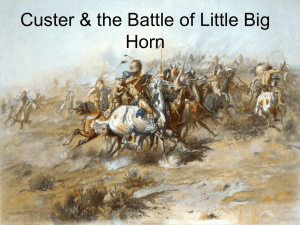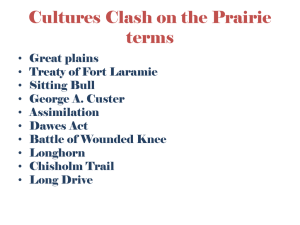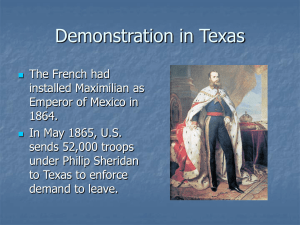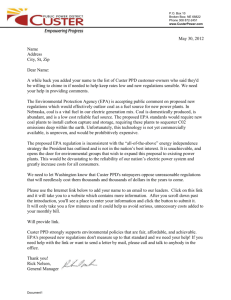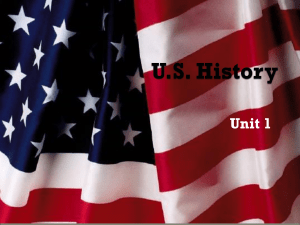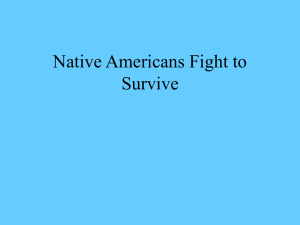Ended the Plains Indian Wars. 10000 years of culture wiped out in a
advertisement
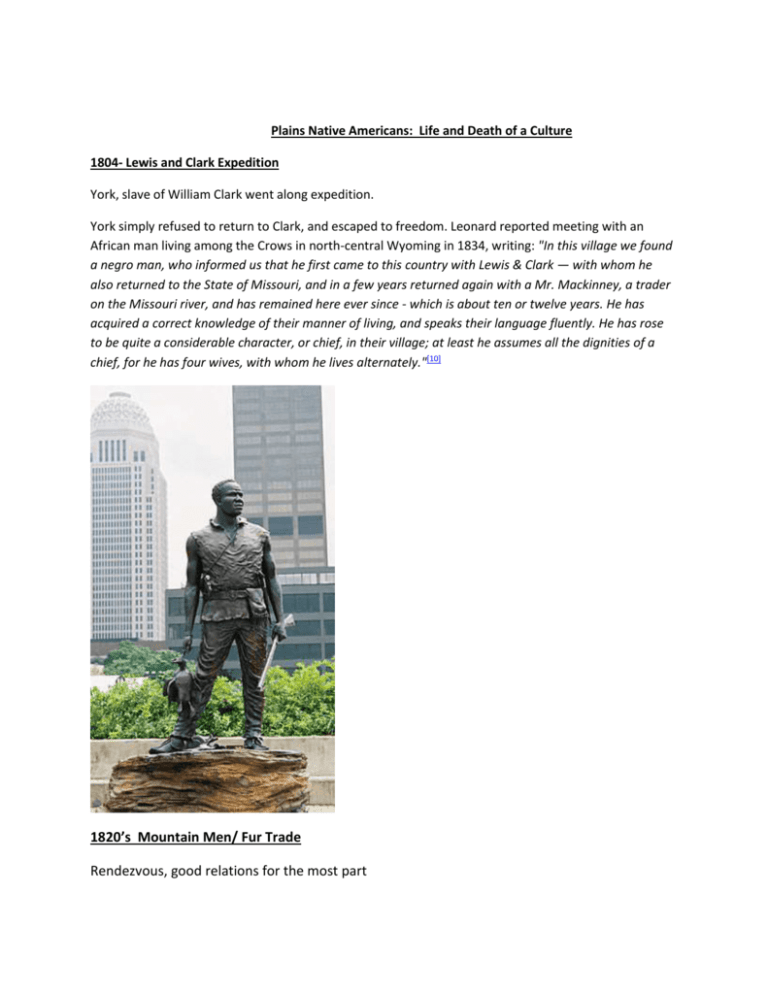
Plains Native Americans: Life and Death of a Culture 1804- Lewis and Clark Expedition York, slave of William Clark went along expedition. York simply refused to return to Clark, and escaped to freedom. Leonard reported meeting with an African man living among the Crows in north-central Wyoming in 1834, writing: "In this village we found a negro man, who informed us that he first came to this country with Lewis & Clark — with whom he also returned to the State of Missouri, and in a few years returned again with a Mr. Mackinney, a trader on the Missouri river, and has remained here ever since - which is about ten or twelve years. He has acquired a correct knowledge of their manner of living, and speaks their language fluently. He has rose to be quite a considerable character, or chief, in their village; at least he assumes all the dignities of a chief, for he has four wives, with whom he lives alternately."[10] 1820’s Mountain Men/ Fur Trade Rendezvous, good relations for the most part 1847- Mormons arrive in Utah 1849-1850s: California Gold Rush Increase traffic and settlement of white man through Indian territory 1851: Fort Laramie Treaty Guaranteeing to the Lakota ownership of the Black Hills, and further land and hunting rights in South Dakota, Wyoming, and Montana. The Powder River Country was to be henceforth closed to all whites In the treaty, as part of the U.S. vendetta to "divide and conquer", the U.S. included all Ponca lands in the Great Sioux Reservation. Conflict between the Ponca and the Sioux/Lakota, who now claimed the land as their own by U.S. law, forced the U.S. to remove the Ponca from their own ancestral lands in Nebraska to poor land in Oklahoma. The treaty includes an article intended to "ensure the civilization" of the Lakota, financial incentives for them to farm land and become competitive, and stipulations that minors should be provided with an "English education" at a "mission building." To this end the U.S. government included in the treaty that white teachers, blacksmiths, a farmer, a miller, a carpenter, an engineer and a government agent should take up residence within the reservation. Repeated violations of the otherwise exclusive rights to the land by gold prospectors led to the Black Hills War. Migrant workers seeking gold had crossed the reservation borders, in violation of the treaty. Indians had assaulted these gold prospectors, in violation of the treaty, and war ensued. The U.S. government seized the Black Hills land in 1877. (Land ownership was considered preposterous, like owning air.) More than a century later, the Sioux nation won a victory in court. On June 30, 1980, in United States v. Sioux Nation of Indians,[2] the United States Supreme Court upheld an award of $15.5 million for the market value of the land in 1877, along with 103 years worth of interest at 5 percent, for an additional $105 million. The Lakota Sioux, however, refused to accept payment and instead demanded the return of their territory from the United States. 1861-1865: Civil War Soldiers of merit were fighting the Civil War, on the plains you had the soldiers that the army didn’t want. 1863 Bear River Massacre (Patrick Conner, UT/ID border) Single largest killing of Native Americans, 250-300 killed. 1864 Sand Creek Massacre (John Chivington) Chivington was a sociopath in a uniform. In charge of volunteer soldiers out of Colorado. Some bands of Cheyenne did not agree with those who signed the treaty and chose to ignore it, going on to live as they always had. They were found to be violating the treaty and were attacked. Black Kettle, one of the leaders of a band of 800 went to negotiate peace. Went back to camp and even flew the American flag as a symbol of peace at the campsite. The next morning, Chivington ordered the attack. Two commanders refused and told their men to hold fire, but Chivington’s men attacked, even under the American flag and when a white flag was raised. I saw the bodies of those lying there cut all to pieces, worse mutilated than any I ever saw before; the women cut all to pieces ... With knives; scalped; their brains knocked out; children two or three months old; all ages lying there, from sucking infants up to warriors ... By whom were they mutilated? By the United States troops ... —- John S. Smith, Congressional Testimony of Mr. John S. Smith, 1865[20] Fingers and ears were cut off the bodies for the jewelry they carried. The body of White Antelope, lying solitarily in the creek bed, was a prime target. Besides scalping him the soldiers cut off his nose, ears, and testicles-the last for a tobacco pouch ... —- Stan Hoig[21] Jis to think of that dog Chivington and his dirty hounds, up thar at Sand Creek. His men shot down squaws, and blew the brains out of little innocent children. You call sich soldiers Christians, do ye? And Indians savages? What der yer 'spose our Heavenly Father, who made both them and us, thinks of these things? I tell you what, I don't like a hostile red skin any more than you do. And when they are hostile, I've fought 'em, hard as any man. But I never yet drew a bead on a squaw or papoose, and I despise the man who would. Soldiers scalped the dead, cut out genitals and arranged them suggestively, mutilations. 100 scalps were displayed in a Denver theater. 1865- Red Cloud War/Fetterman Massacre (Crazy Horse) This was the only war that the Indians won. They wanted the Bozeman Trail closed, it went through their sacred lands. Fetterman said he was going to ride through and kill the Sioux. All 80 of Fetterman’s men were killed. 1868-Red Cloud War over Bozeman Trail closed – Washita Massacre (George A. Custer) 200 Indian warriors raided villages, killing 15, reported to have raped some women, and took some people captive. Black Kettle learned of this and wanted to send those responsible to white authorities. Soldiers are spotted by the Indians closing in on their camp a few miles out, heavy snow, plans made to send out someone to talk with soldiers in morning. The attack Map of the battle. On November 26, 1868, Custer’s Osage scouts located the trail of an Indian war party. Custer's troops followed this trail all day without a break until nightfall, when they rested briefly until there was sufficient moonlight to continue. When they reached Black Kettle’s village, Custer divided his force into four parts, each moving into position so that at first daylight they could simultaneously converge on the village.[37] At daybreak, as the columns attacked, Double Wolf awoke and fired his gun to alert the village; he was among the first to die in the charge.[38] The Cheyenne warriors hurriedly left their lodges to take cover behind trees and in deep ravines. Custer soon controlled the village, but it took longer to quell all remaining resistance.[39] Black Kettle and his wife, Medicine Woman Later, were shot in the back and killed while fleeing on a pony.[40][41] Following the capture of Black Kettle's village, Custer found himself in a precarious position. As the fighting began to subside, he saw large groups of mounted Indians gathering on nearby hilltops and learned that Black Kettle's village was only one of many Indian encampments along the river. Fearing an attack, he ordered some of his men to take defensive positions while the others were to seize the Indians' belongings and horses. They destroyed what they did not want or could not carry, including about 675 ponies and horses. They spared 200 horses to carry prisoners.[42] General Custer's command marching to attack the Cheyenne village., 1868 Near nightfall, fearing the outlying Indians would find and attack his supply train, Custer began marching toward the other encampments. The surrounding Indians retreated, at which point Custer turned around and returned to his supply train.] In his first report of the battle to Gen. Sheridan on November 28, 1868, Custer reported that by "actual and careful examination after the battle," his men found the bodies of 103 warriors] — a figure echoed by Sheridan when he relayed news of the Washita fight to Bvt. Maj. Gen. W.A. Nichols the following day. In fact, no count of the dead had been made. The reported number was based on Custer's reports from his officers the day after the attack, during their return to Camp Supply. Cheyenne and other Indian estimates of the Indian casualties at the Washita, as well as estimates by Custer's civilian scouts, are much lower. According to a modern account by the United States Army Center of Military History, the 7th Cavalry had 21 officers and men killed and 13 wounded at the Washita. They estimated the Indians had perhaps 50 killed and as many wounded.[36] Twenty of the soldiers killed were part of a small detachment led by Major Joel Elliott,[49] who was among the dead. Elliott had separated from the three companies he led, apparently without Custer's approval. Yelling "Here's for a brevet or a coffin!",[50][51] Elliott and his small band pursued a group of fleeing Cheyenne. Elliott's contingent ran into a mixed party of Cheyenne, Kiowa, and Arapaho warriors who were rushing from villages up the river to aid Black Kettle's encampment.[52] The warriors overwhelmed the small troop in a single charge.[49] Custer's abrupt withdrawal without determining the fate of Elliott and the missing troopers darkened Custer's reputation among his peers. There was deep resentment within the 7th Cavalry that never healed.[53] In particular, Eliott's friend and H Company captain Frederick Benteen never forgave Custer for "abandoning" Elliott and his troopers. Eight years later, when Benteen failed to race to Custer's aid at the Battle of the Little Bighorn, his actions were closely examined in light of his long-standing anger toward Custer for the events at the Washita River. By early December 1868, the attack had provoked debate and criticism in the press. In the December 9 Leavenworth Evening Bulletin, an article noted: "Gen. S. Sandford and Tappan, and Col. Taylor of the Indian Peace Commission, unite in the opinion that the late battle with the Indians was simply an attack upon peaceful bands, which were on the march to their new reservations". The December 14 New York Tribune reported, "Col. Wynkoop, agent for the Cheyenne and Arapahos Indians, has published his letter of resignation. He regards Gen. Custer's late fight as simply a massacre, and says that Black Kettle and his band, friendly Indians, were, when attacked, on their way to their reservation." The scout James S. Morrison wrote Indian Agent Col. Wynkoop that twice as many women and children as warriors had been killed during the attack. The Fort Cobb Indian trader William Griffenstein told Lt. Col. Custer that the 7th U.S. Cavalry had attacked friendly Indians on the Washita. General Phillip Sheridan ordered Griffenstein out of Indian Territory and threatened to hang him if he returned.[] The New York Times published a letter describing Custer as taking "sadistic pleasure in slaughtering the Indian ponies and dogs." It alluded to his forces' having killed innocent women and children. 1873- The Panic of 1873 (1873-1877) Railroads/Loans Economy collapses and U.S. in debt, looking for gold. 1874- Custer’s expedition into Black Hills Finds gold in Black Hills 1876- Little Big Horn (Custer’s Last Stand) Expedition launched to trap Native Americans in 3 pronged attack. Crazy Horse attacks Crook and beats him, Crook turns back. Custer finds Indians at Little Big Horn River, splits troops, thinks he is invincible. Custer very visible on ridge. 8,000-9,000 Indians, Custer has 300 men. Custer sends for reinforcement, message not relayed. Trapped for 2 days. Everyone in Custer’s command is killed, 9 days before 100 year anniversary of country. “Barbarians have to go!” Custer a media darling. After that, U.S. went after Indians even more. How? Get rid of their food, killed buffalo by the millions. 1880’s- Systematic slaughter of buffalo/ removal/ reservation system http://www.history.com/topics/wounded-knee/videos#american-buffalo http://www.history.com/topics/wounded-knee/videos#the-buffalo-and-native-americans 1887- Dawes Act Destroyed the culture of Native Americans. Native children taken from families, couldn’t be an Indian. Sitting Bull paraded in Buffalo Bill’s Wild West Show, then assassinated. Death of Sitting Bull 1890- Wounded Knee Massacre Ended the Plains Indian Wars. 10,000 years of culture wiped out in a short time. http://www.history.com/topics/native-american-cultures/videos#the-last-of-the-sioux Who was out there? (it wasn’t Kevin Costner) Cavalry, 5’6” tall, 145 lbs or lighter. Army had mandatory enrollment, 21 yrs old = six years of service. Had choice between jail or army. Issued 1 pr pants, 1 coat, 1 hat, 2 gray flannel shirts. 2 boots (no right or left and one size) Boots had nails poking into the foot, issued a file to file down “brass tacks”. Food: Left over from the Civil War- weavel infested coffee, rancid bacon, hard tack (crackers) used to stop bullets (hid behind boxes of it). No veggies unless they grew their own. Desertion 33%, higher than ever, even with nowhere to go. Most had never fired weapons before, ammo too expensive, no training. 10% suicide, 80% alcoholics Life on the Plains was nothing like the movies, horrible, battles everywhere. Crazy Horse surrendered because people were starving. Assassinated. Never submitted to white people. Touch the Clouds 7 ft tall Sioux warrior took care of Crazy Horse’s body. 1492- 6 million Native Americans 1900- 230,000 Native Americans (most dying of disease)

